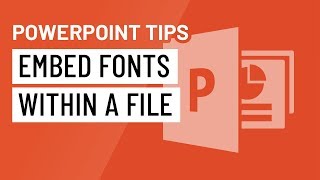
Introduction:
Microsoft PowerPoint, a cornerstone in the world of presentations, offers a myriad of features to ensure visual excellence. Typography plays a crucial role in design, and selecting the right fonts is an essential aspect of creating impactful slides. However, ensuring that your chosen fonts display correctly on different devices can be a challenge. The solution to this challenge lies in embedding fonts within a PowerPoint file. In this extensive guide, we will delve into the intricacies of embedding fonts in PowerPoint, exploring the methods, benefits, and advanced techniques that empower presenters to achieve consistent and visually appealing typography across various platforms.
I. Understanding the Need to Embed Fonts in PowerPoint:
A. Font Rendering Discrepancies:
- Fonts may appear differently on various devices due to differences in font availability.
- Embedding fonts ensures that your presentation displays as intended, regardless of the device used for viewing.
B. Custom and Non-Standard Fonts:
- Presenters often use custom or non-standard fonts to establish brand identity or convey a specific aesthetic.
- Embedding these fonts guarantees that they are available to viewers who may not have the same fonts installed on their devices.
II. Basic Methods for Embedding Fonts in PowerPoint:
A. Font Embedding by Default:
- In PowerPoint, fonts are embedded by default when creating a presentation.
- This default setting ensures that standard fonts used in the presentation are included within the file.
B. Custom Fonts and Embedding Options:
- Custom fonts may not be automatically embedded, requiring manual intervention.
- Users can access the “Save Options” when saving a presentation and select the “Embed fonts in the file” checkbox to include custom fonts.
III. Verifying Embedded Fonts:
A. Checking Font Embedding Status:
- Users can verify the embedded fonts in a PowerPoint file by accessing the “File” tab and selecting “Info.”
- Under “Related Documents,” users can click on “Manage Embedded Fonts” to view the list of embedded fonts.
B. Font Substitution Warnings:
- PowerPoint may issue warnings if fonts are not embedded or if there are potential font substitution issues.
- Addressing these warnings during the creation process ensures that fonts are embedded correctly.
IV. Benefits of Embedding Fonts in PowerPoint:
A. Consistent Design:
- Embedded fonts ensure a consistent design across different devices and platforms.
- Viewers see the presentation exactly as intended, preserving the visual integrity of the design.
B. Brand Identity Preservation:
- Brands often use specific fonts to establish identity.
- Embedding these fonts safeguards brand consistency, even when presentations are shared externally.
V. Advanced Techniques for Font Embedding:
A. Embedding Specific Fonts Only:
- Users can choose to embed only specific fonts rather than embedding all fonts used in the presentation.
- This selective embedding minimizes file size while ensuring critical fonts are included.
B. Optimizing Font Usage:
- Users can optimize font usage by limiting the number of fonts used in a presentation.
- Streamlining fonts reduces the need for extensive embedding and simplifies font management.
VI. Troubleshooting and Common Challenges:
A. File Size Concerns:
- Embedding fonts can contribute to larger file sizes.
- Balancing font embedding with file size considerations is crucial, especially for presentations shared online.
B. Compatibility with Older Versions:
- Presentations with embedded fonts may face compatibility issues with older versions of PowerPoint.
- Saving presentations in compatible formats addresses compatibility concerns.
VII. Conclusion:
In the intricate tapestry of PowerPoint presentations, embedding fonts emerges as a critical practice for ensuring consistent and visually appealing typography across diverse devices. This comprehensive guide equips presenters with the knowledge and techniques needed to master font embedding, from basic methods to advanced applications and troubleshooting. By embedding fonts strategically, presenters can elevate their presentations, ensuring that design elements, brand identity, and visual appeal remain intact, captivating audiences with a polished and professional typographic experience. Embrace the power of embedded fonts in PowerPoint, and transform your presentations into seamless visual narratives that leave a lasting impression on your audience.